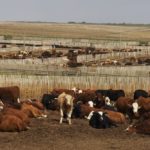Reading Time: 2 minutes Compared to last week, western Canadian feeder cattle traded $8-$10 lower while U.S. prices were also down $5-$10 from week-ago levels. The feeder market appeared to short-circuit after I thought the market was charged to move higher in last week’s report. Feedlot operators and cattle feeders saturated their demand prior to the New Year and […] Read more

Klassen: Feeder market lacks demand in new tax year

Klassen: Fed cattle market leads feeders higher
Reading Time: 2 minutes Alberta packers were buying fed cattle in the range of $280-$282 delivered on a dressed basis, which equates to $168-$171 on a live basis. Yearlings bought last summer are bringing back $150-$180 margin, which has reinforced buying enthusiasm. Western Canadian yearlings traded $3 to as much as $8 above week-ago levels; calves were relatively unchanged […] Read more

Klassen: Feeder market remains firm into 2018
Reading Time: 2 minutes Western Canadian feeder cattle markets experienced limited activity over the past week because most auction barns were closed for the holiday season. There was some reported activity in certain regions such as central Alberta and prices were relatively unchanged from seven days earlier. Frigid temperatures tempered buying activity. Feedlots in the nearby area of the […] Read more

Klassen: Feeder market ends 2017 on positive tone
Reading Time: 2 minutes Compared to last week, western Canadian feeder cattle markets traded $2 to as much as $6 higher. Moderate to stronger buying interest was noted across the Prairies. Once again, feedlot operators were fairly aggressive on quality yearling packages; semi-weaned and weaned calves were a solid $3-$5 higher while unweaned lighter calves experienced minimal price appreciation. […] Read more

U.S. feedlot cattle placements bigger than expected
Reading Time: 2 minutes Chicago | Reuters — Ranchers drove 13.9 per cent more cattle into U.S. feedlots in November than the same time a year ago, the U.S. Department of Agriculture reported on Friday. The result exceeded the high end of the range of analysts’ forecasts, partly fueled by low feed prices in the wake of this fall’s […] Read more

Klassen: Stronger fed cattle market underpins feeder complex
Reading Time: 2 minutes Alberta fed cattle prices surged $11-$12 this past week, with packers buying fed cattle in the range of $262-$264 on a dressed basis. While most feedlot operations are carrying sufficient numbers at this time of year, quality packages of heavier replacements were extremely precious. Yearlings and calves above 850 lbs. sold steady to $5 above […] Read more

Klassen: Feeder cattle market falters
Reading Time: 2 minutes Compared to last week, western Canadian feeder cattle markets traded $3 to as much as $6 lower. Alberta feeder cattle prices appeared to move in line with major U.S. markets, which were also down $3-$5 from week-ago levels; however, minimal slippage was noted in eastern Saskatchewan and Manitoba. Weakness in deferred live and feeder cattle […] Read more

Klassen: Tight margins weigh on feeder cattle
Reading Time: 2 minutes Compared to last week, western Canadian feeder cattle prices traded $5 higher to $5 lower; however, yearlings were a solid $2 to $4 lower. Negative feeding margins over the past month, along with weakness in the deferred live cattle futures, set a negative tone in the heavier weight classes. The calf market appears to be […] Read more

Klassen: Winter weather weighs on feeder complex
Reading Time: 2 minutes Compared to last week, western Canadian feeder cattle prices were relatively unchanged. However, quality features played a larger role in the price structure. Buyers shied away on fleshier yearlings which is often the case when margins move into negative territory. It’s that time of year when thicker coats can be somewhat misleading and buyers pulled […] Read more

Klassen: Feeder market rally stalls
Reading Time: 2 minutes Western Canadian feeder cattle prices were relatively unchanged from week-ago levels. Eastern Prairie markets were softer but continue to maintain a $5 to as much as $8 premium over major feeding regions of Alberta. We’ve seen a sharp year-over-year increase in imports from the U.S., which is causing a variable price structure to develop across […] Read more


